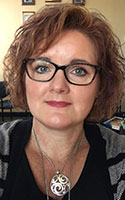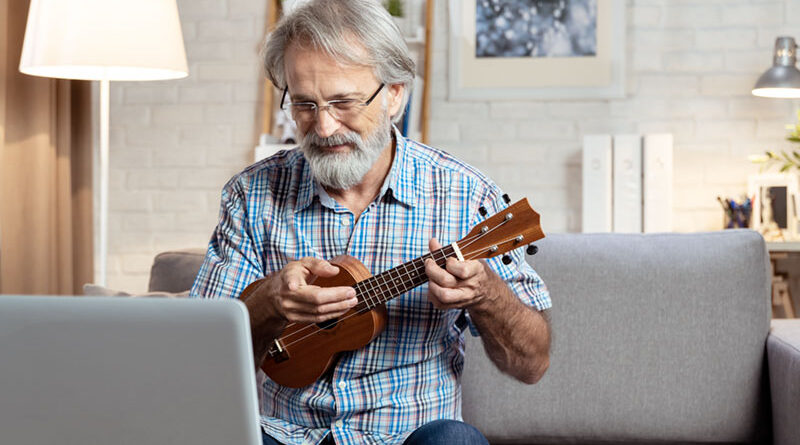Adult Enrichment Classes Continue… Virtually
Organizations turning to technology to help members stay connected during pandemic
By Deborah Jeanne Sergeant

Adult enrichment classes provide socialization opportunities for many older adults. Though schooldays are long since passed for most, joining a class to learn more about an engaging subject is plain fun.
When the pandemic hit in March, leaders at organizations such as PEACE, Inc., in Syracuse knew that enrichment classes could not continue. However, online streaming proved challenging to some of their participants.
“Our target audience for seniors is those who are moderate to lower income,” said Elizabeth A. O’Hara, program director at PEACE, Inc. “We’re at a disadvantage because they don’t have the tech equipment or skills to stay connected. We have not done online activities or enrichment.”
Just a handful of participants have access to computers at home and can navigate Zoom. However, the majority do not. At the beginning of the pandemic, PEACE purchased 25 tablets for a program to help more people participate remotely. However, the recipients did not know how to use them.
“I intended last fall to bring in small groups to train but we had to cancel that,” O’Hara said. “We will have to wait. We have plans once the pandemic winds down to address the tech connectivity.”
For some participants who live alone, their contact with PEACE is their main way of having someone check in on them. O’Hara said that to continue that benefit during the pandemic, PEACE made weekly calls to ensure seniors had food and their prescriptions.
“We were trying to decrease their social isolation,” O’Hara said.
The group also helped their participants understand why social distancing and wearing masks is important. Eventually, some of them said that they did not need a call each week; others welcomed the socializing. Still others began calling each other, an unexpected result that pleases O’Hara.
PEACE began sending postal mail as well, including a newsletter.
For those who could manage Zoom, the sessions were mainly to talk about the topics in the newsletter and to discuss current events.
PEACE also hosted a drive-through party in December where conversation through the car window and a take-away goody bag sufficed.
“We were pleased to see them and they were pleased to see us,” O’Hara said. “They’re all eager to get back to normal, but it will be while.”
Once the weather warms up, the group should be able to resume its walking program with social distancing and masks. O’Hara hopes that with the same precautions, the group can meet for outdoor lunches.
O’Hara feels pleased that the agency did not close during the pandemic.
“It was our priority to make sure our clients were served,” she said.
Oasis in Syracuse shifted its programming to Zoom. Cynthia Cary Woods, executive director, said that its current 263 classes represent about one-third of Oasis’ usual number.
“It’s not as perfect as in-person, but they have one or two hours similar to ‘normal,’” Woods said.
Many of Oasis’ members have access to high-speed internet and a level of aptitude for connecting through Zoom.
“It’s exciting to see how they’ve embraced it and learned the Zoom platform,” Woods said. “Some of the staff was oriented in a trial-by-fire way.”
A few Oasis instructors familiar with Zoom produced a video on how to use Zoom. At the beginning of each Oasis semester, a link to that video is sent out to the members with the notification that classes are starting soon. Oasis Syracuse normally has about 2,300 active members and is maintaining about 1,500 through the pandemic.
The largest room available holds 120 attendees, but with current restrictions would host only 40 to allow social distancing if Oasis opened up for in-person classes.
“My goal is to make sure all of my staff is vaccinated before reopening,” Woods said. “We’re creating a participant study to gauge the interest in returning to in-person. We have people with health issues who want to keep doing it virtually because it feels safer.”
She sees other advantages to using Zoom, such as the end of snow days, filled classes and the issue of living too far away. In 2020, 95 have joined Oasis and half of those do not live locally.
“We have snowbirds who go to Florida and tell their friends,” Woods said. “Now their friends are taking our classes online because they’re interested in something to do.”
Virtual expansion also includes offering content from the eight other Oasis sites nationwide, a project that the pandemic pushed forward by necessity.
For those who do not participate through Zoom, Oasis checks in with a weekly phone call to decrease isolation. Oasis has also helped train other organizations on how to perform check-ins by phone.
An Oasis member established a scholarship to provide tech education in underserved areas like Syracuse Housing so more can learn how to Zoom.
“A lot have smartphones, but don’t know how to safely use the Internet,” Woods said. “This has highlighted the digital divide. Many come to Oasis because they want to keep their minds engaged. If they stay involved in the community and active, they age better. That’s what we all want.”
At the Jewish Community Center of Syracuse, many of the programs have carried on through Zoom. Since JCC provides numerous programs for older adults, Patrick Scott, sports and fitness director at JCC, thinks this is helping more older people stay active and connected during the pandemic.
“We’ve been Zooming a lot of classes, like chair-based Tai Chi and line dancing,” he said. “A lot of older adults – both participants and instructors – have been nervous about coming back. We have a select number on in-person.”
But instead of the usual 55 classes a week, JCC is down to six in-person classes a week.
Scott thinks that a lot of members have called upon their children to help them become accustomed to Zoom. JCC personnel have also helped walk people through it.
Those who want to participate in person must make an online reservation. This helps limit the number of people in the building to enable thinner crowds. Those who cannot make online reservations call.
Although it has been a tough transition at times, Scott is pleased about getting class sign-ups mostly online and that participants are learning Zoom and other technology skills. Even as in-person classes resume, he plans to keep offering Zoom as an option. That can help members nervous about driving in bad weather and those who want to take two concurrent classes.
JCC hopes to resume in-person outdoor classes once the weather improves.
“For a lot of our members, this is the only interaction they’ve had for the past year, learning how to Zoom to talk with their grandkids who live far away or even locally if the kids aren’t coming over to see grandma,” Scott said. “A lot of people are still nervous about venturing out of their houses. I think any interaction we can give them is helpful.”
Members can “hang out” after a class on Zoom if they wish.
At the YMCA of Central New York in Syracuse, Stephanie Noble, director of marketing and communications, said that although the fitness facilities closed last spring, the organization’s emergency community outreach has continued. The life enrichment programming, which attracts numerous retirees, continued virtually.
“In the fall, we were able to provide full programming at limited capacity,” Noble said. “We continue to offer a full range of Y programming in our facilities and online, with capacity and safety guidelines in place to keep our community healthy.”
Leadership at the organization realized that many older adults missed the programming at the YMCA, but the Centers for Disease Control and Prevention identified older adults as a population particularly susceptible to severe illness with COVID-19. That is why YMCA adapted to a virtual format for some of its programming popular with older adults, such as low-impact fitness classes, but walking groups have continued meeting with masking and social distancing in place.
“The Y is here for all ages, abilities and backgrounds, but our 55-plus community has always been very special,” Noble said. “We see the strong bonds and friendships that have grown out of classes and programs at the Y and want to make sure that connection continues for our members.
“Feelings of isolation can be very present during this pandemic, but older adults are also occasionally dealing with the loss of a spouse, distant family and a loss of mobility. The Y is here to help connect people and be a resource to ensure a strong mind, body, and spirit for our community.”

